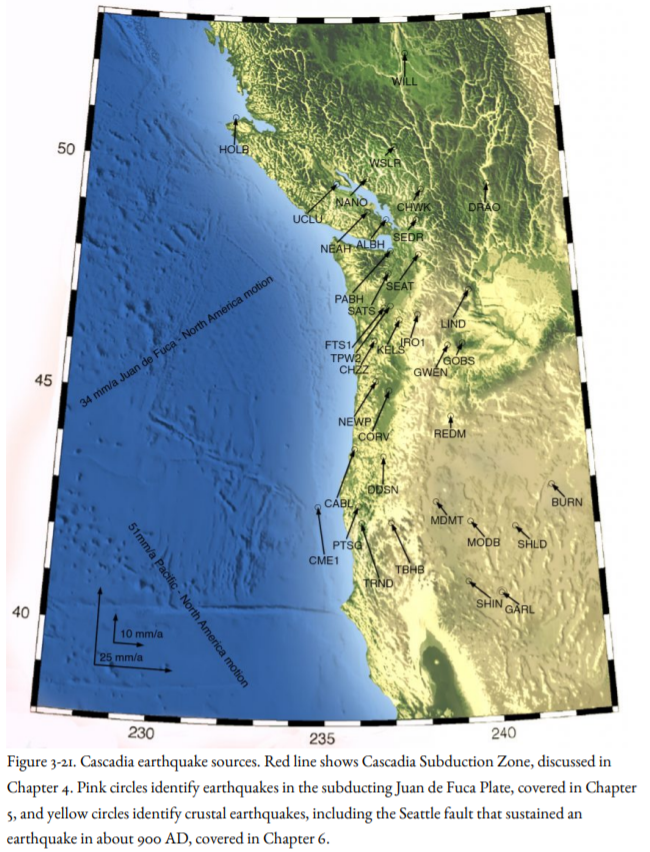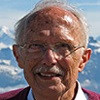5.3.9: Cascadia Earthquake Sources
- Page ID
- 5924
Overview
The next three chapters describe the three sources of earthquakes in the Pacific Northwest (Figure 3-21). Chapter 4 describes the first and largest source, the boundary between the Juan de Fuca-Gorda Plate and the North America Plate, known as the Cascadia Subduction Zone (solid red line in Figure 3-21). Chapter 5 describes deep earthquakes, largely onshore, within the downgoing Juan de Fuca Plate, called slab earthquakes. Chapter 6 describes earthquakes within the North America Plate, including the Seattle fault in Washington and two earthquakes in Oregon in 1993.

Suggestions For Further Reading
Bakun, W. H., R. A. Haugerud, M. G. Hopper, and R. S. Ludwin. 2002. The December 1872 Washington State Earthquake: Bulletin of the Seismological Society of America, v. 92, p. 3239-58.
Bakun, W. H., and C. M. Wentworth. 1997. Estimating earthquake location and magnitude from seismic intensity data: Bulletin of the Seismological Society of America, v. 87, p. 1502-21.
Bolt, B. A. 2004. Earthquakes: 5th Edition: New York: W. H. Freeman & Co., 378 p. A more detailed discussion of seismographs and seismic waves, written for the lay person.
Brumbaugh, D. S. 1999. Earthquakes: Science and Society. Upper Saddle River, NJ: Prentice-Hall. In-depth coverage of earthquakes, instruments used in describing them, and personal safety and building construction standards.
Committee on the Science of Earthquakes. 2003. Living on an Active Earth: Perspectives on Earthquake Science. Washingon, D.C.: National Academy Press, 418 p., www.nap.edu
Carter, W. E., and D. S. Robertson. 1986. Studying the earth by very-long-baseline interferometry: Scientific American, v. 255, no. 5, p. 46-54. Written for the layperson.
Dixon, T. H. 1991. An introduction to the Global Positioning System and some geological applications: Reviews of Geophysics, v. 29, p. 249-76.
Hough, S. E. 2002. Earthshaking Science: What We Know (And Don’t Know) About Earthquakes. Princeton, NJ: Princeton University Press, 238 p. Written for the layperson.
Iris Seismic Monitor. http://www.iris.edu/seismon/ Monitor earthquakes around the world in near-real-time, visit worldwide seismic stations. Earthquakes of M 6 or larger are linked to special information pages that explain the where, how, and why of each earthquake.
Lee, W. H. K. 1992. Seismology, observational. Academic Press, Encyclopedia of Physical Science and Technology, v. 15, p. 17-45.
Lillie, R. J. 1999. Whole-Earth Geophysics: Englewood Cliffs, NJ: Prentice-Hall, 361 p.
Prescott, W. H., J. L. Davis, and J. L. Svarc. 1989. Global positioning system measurements for crustal deformation: Precision and accuracy. Science, v. 244, p. 1337-40.
Richter, C. F., 1958, Elementary Seismology: San Francisco: W.H. Freeman and Co., 468 p. The classic textbook in earthquake seismology, still useful after more than forty years.
Scholz, C. 2002. Mechanics of Earthquakes and Faulting, Second Edition. Cambridge University Press, 496 p. A technical treatment of how rocks deform and produce earthquakes.
SCIGN website designed as a learning module for tectonic geodesy: http://scign.jpl.nasa.gov/learn/
Wald, D. J., V. Quitoriano, T. Heaton, H. Kanamori, C. W. Scrivner, and C. W. Worden. 1999. TriNet ShakeMaps: Rapid generation of instrumental ground motion and intensity maps for earthquakes in southern California. Earthquake Spectra, v. 15, p. 537-55.
Wald, D. J., C. B. Worden, and V. Quatoriano. 2002. ShakeMap: an update. Seismological Research Letters, v. 73, p. 255.
Yeats, R. S., K. E. Sieh, and C. R. Allen. 1997. The Geology of Earthquakes. New York: Oxford University Press, 568 p., chapters 2, 3, 4, and 5, p. 17-113.


